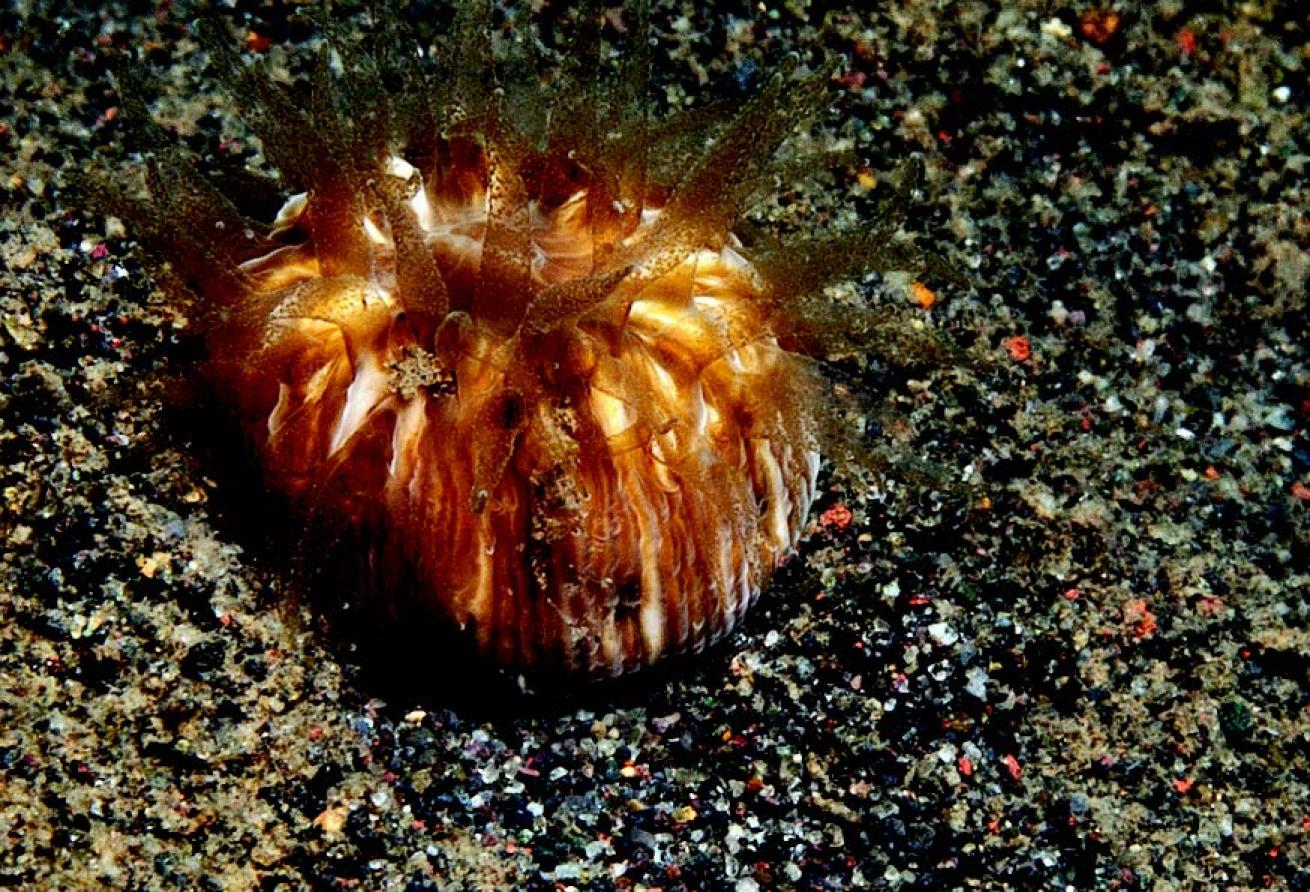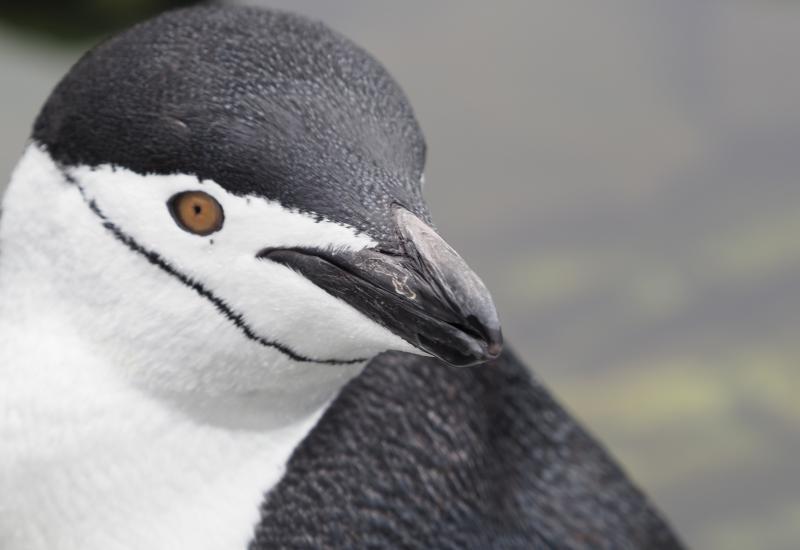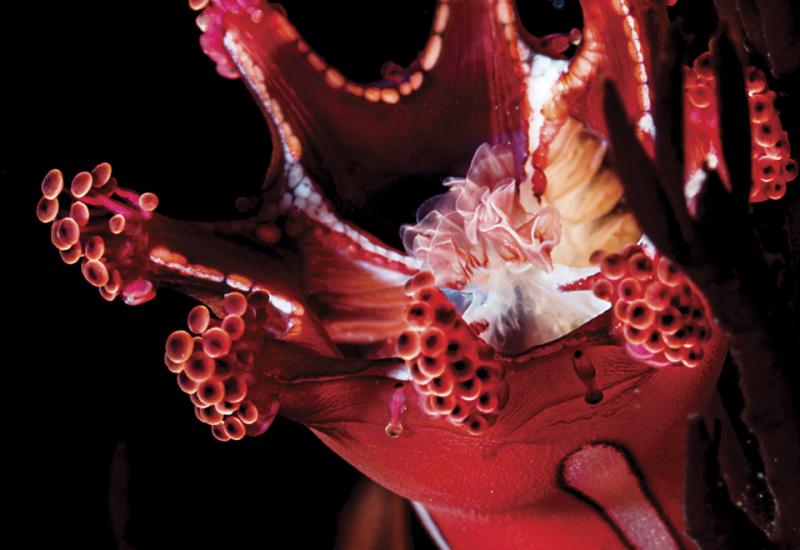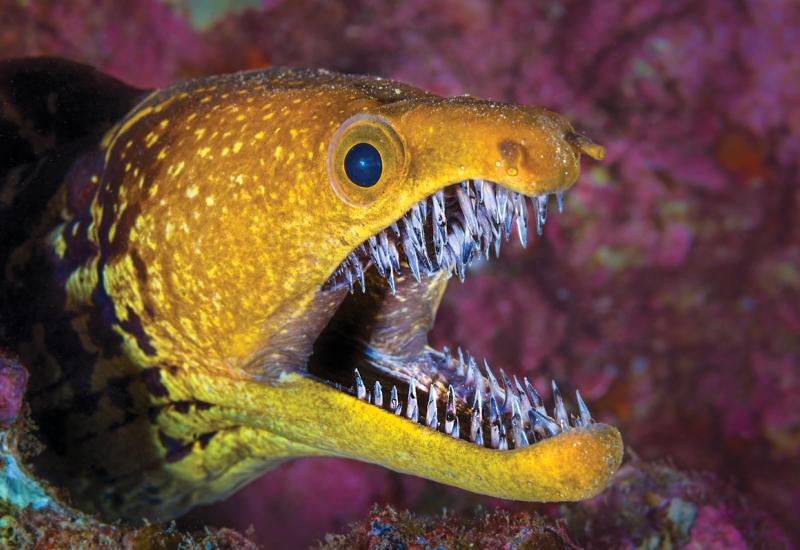Critter Hunt: Walking Coral

Walking Coral
Peanut worms use non-colonizing stony corals as mobile homes.
Ned and Anna DeLoach
I thought my eyes were playing tricks on me. But no, there it was again: I distinctly saw a piece of stony coral move across the black-sand bottom of Puri Jati, a muck-diving site on the northern coast of Bali.
As proof my eyes weren’t deceiving me, the ambulatory coral left a 4-inch-long trough in the sand. Intrigued, I picked up and examined one of the many similar thimble-size corallites scattered about the bottom. All appeared normal, except for a small hole toward one side of the coral’s smooth base.
Glancing around to show Anna, I found her kneeling on the sand, also inspecting one of the corallites. When she looked up at me questioningly, all I could do was shrug. She shrugged back and spilled a couple of dead pieces into her BC pocket.
That evening, Anna emailed a snapshot of our finding to coral researcher Dr. Judith Lang. The following morning, our puzzle was solved. Lang identified the coral as either Heterocyathus or Heteropsammia, noncolonizing stony corals that share an interesting symbiotic lifestyle with a species of peanut worm.
It seems that coral larvae of these particular species settle on abandoned gastropod shells that are already — or will soon be — inhabited by tiny peanut worms. As the corals grow they spread over the shell, leaving a tiny hole in the bottom. The opening allows the worm to feed and move the coral about. Both organisms benefit: The worm keeps the coral from being buried in the soft sediment, and sets it back upright when necessary. In turn, the worm occupies living quarters that expands as it grows. Unlike the hermit crab, which has to find a new home whenever its body outgrows its old shell, the peanut worm has a home for life.
More Critter Hunts from Ned and Anna DeLoach:
Upside Down Treasures | Caribbean Hideaway | Jellyfish Gardening

Ned and Anna DeLoachPeanut worms use non-colonizing stony corals as mobile homes.
I thought my eyes were playing tricks on me. But no, there it was again: I distinctly saw a piece of stony coral move across the black-sand bottom of Puri Jati, a muck-diving site on the northern coast of Bali.
As proof my eyes weren’t deceiving me, the ambulatory coral left a 4-inch-long trough in the sand. Intrigued, I picked up and examined one of the many similar thimble-size corallites scattered about the bottom. All appeared normal, except for a small hole toward one side of the coral’s smooth base.
Glancing around to show Anna, I found her kneeling on the sand, also inspecting one of the corallites. When she looked up at me questioningly, all I could do was shrug. She shrugged back and spilled a couple of dead pieces into her BC pocket.
That evening, Anna emailed a snapshot of our finding to coral researcher Dr. Judith Lang. The following morning, our puzzle was solved. Lang identified the coral as either Heterocyathus or Heteropsammia, noncolonizing stony corals that share an interesting symbiotic lifestyle with a species of peanut worm.
It seems that coral larvae of these particular species settle on abandoned gastropod shells that are already — or will soon be — inhabited by tiny peanut worms. As the corals grow they spread over the shell, leaving a tiny hole in the bottom. The opening allows the worm to feed and move the coral about. Both organisms benefit: The worm keeps the coral from being buried in the soft sediment, and sets it back upright when necessary. In turn, the worm occupies living quarters that expands as it grows. Unlike the hermit crab, which has to find a new home whenever its body outgrows its old shell, the peanut worm has a home for life.
More Critter Hunts from Ned and Anna DeLoach:
Upside Down Treasures | Caribbean Hideaway | Jellyfish Gardening










